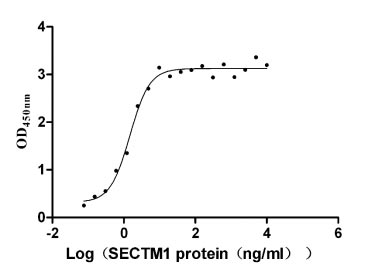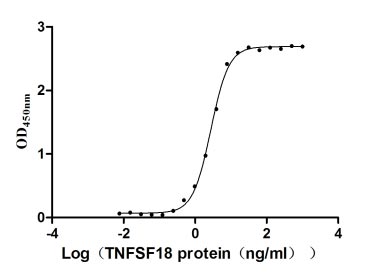Recombinant Mouse BDNF/NT-3 growth factors receptor (Ntrk2), partial
-
货号:CSB-YP016134MO1
-
规格:
-
来源:Yeast
-
其他:
-
货号:CSB-EP016134MO1
-
规格:
-
来源:E.coli
-
其他:
-
货号:CSB-EP016134MO1-B
-
规格:
-
来源:E.coli
-
共轭:Avi-tag Biotinylated
E. coli biotin ligase (BirA) is highly specific in covalently attaching biotin to the 15 amino acid AviTag peptide. This recombinant protein was biotinylated in vivo by AviTag-BirA technology, which method is BriA catalyzes amide linkage between the biotin and the specific lysine of the AviTag.
-
其他:
-
货号:CSB-BP016134MO1
-
规格:
-
来源:Baculovirus
-
其他:
-
货号:CSB-MP016134MO1
-
规格:
-
来源:Mammalian cell
-
其他:
产品详情
-
纯度:>85% (SDS-PAGE)
-
基因名:
-
Uniprot No.:
-
别名:Ntrk2; Trkb; BDNF/NT-3 growth factors receptor; GP145-TrkB/GP95-TrkB; Trk-B; Neurotrophic tyrosine kinase receptor type 2; TrkB tyrosine kinase
-
种属:Mus musculus (Mouse)
-
蛋白长度:Partial
-
蛋白标签:Tag type will be determined during the manufacturing process.
The tag type will be determined during production process. If you have specified tag type, please tell us and we will develop the specified tag preferentially. -
产品提供形式:Lyophilized powder
Note: We will preferentially ship the format that we have in stock, however, if you have any special requirement for the format, please remark your requirement when placing the order, we will prepare according to your demand. -
复溶:We recommend that this vial be briefly centrifuged prior to opening to bring the contents to the bottom. Please reconstitute protein in deionized sterile water to a concentration of 0.1-1.0 mg/mL.We recommend to add 5-50% of glycerol (final concentration) and aliquot for long-term storage at -20℃/-80℃. Our default final concentration of glycerol is 50%. Customers could use it as reference.
-
储存条件:Store at -20°C/-80°C upon receipt, aliquoting is necessary for mutiple use. Avoid repeated freeze-thaw cycles.
-
保质期:The shelf life is related to many factors, storage state, buffer ingredients, storage temperature and the stability of the protein itself.
Generally, the shelf life of liquid form is 6 months at -20°C/-80°C. The shelf life of lyophilized form is 12 months at -20°C/-80°C. -
货期:Delivery time may differ from different purchasing way or location, please kindly consult your local distributors for specific delivery time.Note: All of our proteins are default shipped with normal blue ice packs, if you request to ship with dry ice, please communicate with us in advance and extra fees will be charged.
-
注意事项:Repeated freezing and thawing is not recommended. Store working aliquots at 4°C for up to one week.
-
Datasheet :Please contact us to get it.
相关产品
靶点详情
-
功能:Receptor tyrosine kinase involved in the development and the maturation of the central and the peripheral nervous systems through regulation of neuron survival, proliferation, migration, differentiation, and synapse formation and plasticity. Receptor for BDNF/brain-derived neurotrophic factor and NTF4/neurotrophin-4. Alternatively can also bind NTF3/neurotrophin-3 which is less efficient in activating the receptor but regulates neuron survival through NTRK2. Upon ligand-binding, undergoes homodimerization, autophosphorylation and activation. Rec...显示更多
-
基因功能参考文献:
- Low TRKB Expression is associated with social dominance. PMID: 30282736
- We report here on the incorporation of a BDNF mimetic sequence into a supramolecular peptide amphiphile filamentous nanostructure capable of activating the BDNF receptor TrkB and downstream signaling in primary cortical neurons in vitro. PMID: 30211565
- Data suggest that neurotrophic tyrosine receptor kinase type 2 (TrkB)-dependent neuronal differentiation is involved in the sustained antidepressant effects of ketamine. PMID: 29162814
- increased BDNF-TrkB signaling and synaptogenesis in the nucleus accumbens by deletion of alpha7 nAChR plays a key role in depression PMID: 27821848
- The changes in the expression patterns of proBDNF, BDNF, and their receptors under the influence of chronic alcohol consumption in the depressive ASC strain and nondepressive CBA strain mice are different. PMID: 28900083
- A critical period of susceptibility to cigarette smoke exposure exists in the prenatal and early postnatal period, which results a downregulation in brain-derived neurotrophic factor/tyrosine kinase receptor B signaling in the hippocampus and enhances depression-like behaviors later in life. PMID: 26503133
- Ventral hippocampal trkB is essential to goal-directed action selection, countering habit-based behavior otherwise facilitated by developmental stress hormone exposure. PMID: 29186135
- BDNF acts retrogradely on TrkB in climbing fibers , and facilitates elimination of climbing fibers synapses from Purkinje cells somata during the third postnatal week. PMID: 28775326
- The three receptor sets considered (mAChR, AR and TrkB receptors) intervene in modulating the conditions of the competition between nerve endings. PMID: 27339059
- Signaling through postsynaptic trkB receptors is considered to be an essential part of a cellular mechanism for maintaining the contacts of some, but not all, synaptic contacts onto motoneurons PMID: 27433358
- findings show that BDNF-TrkB signaling, rather than Dopamine signaling, in the Ventral Tegmental Area -Nuc. Accumbens circuit is crucial for facilitating depressive-like depressive-like outcomes after Chronic Social Defeat Stress and they establish BDNF-TrkB signaling as a pathologic mechanism during periods of chronic stress. PMID: 26858215
- inhibition of Sig-1 R prevented cocaine-induced TrkB activation in hippocampal neurons. PMID: 27735948
- After spinal cord injury, astrocyte-specific TrkB knock-out mice showed reduced hyperpathic responses and improved motor coordination. PMID: 28270575
- Results imply that oleanolic acid ameliorates scopolamine-induced memory impairment by modulating the brain-derived neurotrophic factor -ERK1/2-cAMP response element-binding protein pathway through tropomyosin receptor kinase B activation in mice, suggesting that oleanolic acid would be a potential therapeutic agent for the treatment of cognitive deficits. PMID: 27470063
- Data show that c-Jun NH2-terminal kinase (JNK)-interacting protein-3 (JIP3) participates in the migration of cortical neurons during cortical development by mediating TrkB receptor axonal anterograde transport. PMID: 28259553
- findings reveal a spine-autonomous, autocrine signalling mechanism involving NMDAR-CaMKII-dependent BDNF release from stimulated dendritic spines and subsequent TrkB activation on these same spines that is crucial for structural and functional plasticity PMID: 27680698
- Following ethanol administration, phosphorylation of TrkB in the striatum was significantly reduced in wild-type mice. PMID: 26992697
- Results suggest that the therapeutic actions of atypical antidepressant drugs involve various neurocircuits, some of which, but not all, appears to involve BDNF/TrkB and downstream neuroplastic signaling PMID: 26653128
- Observations provide evidence that female-specific induction of estrogen receptor alpha expression confers neuroprotection with TrkB agonist therapy via Src family kinase activation and account for improved functional outcomes in female neonates post-hypoxia and ischemia. PMID: 26839918
- data suggest antidepressant effects of BDNF-TrkB in the NAc, which could not be explained by activation of the transcription factors CREB or beta-catenin. The effects TrkB has on depression-related behavior in different brain regions appear to critically depend on the targeted cell type. PMID: 26315459
- Study indicates that diminished mature BDNF trophic signaling through the TrkB receptor, rather than an induction in proBDNF, is a main contributing factor to the vulnerability of striatal neurons in the zQ175 HD mouse model PMID: 26282324
- TrkB is an endothelial injury-response molecule in atherogenesis. Endothelial brain-derived neurotrophic factor/TrkB signaling reduces VE-cadherin shedding and protects against atherosclerotic lesion development in ApoE-/- mice. PMID: 26431274
- Brain ischaemia induces shedding of a BDNF-scavenger ectodomain from TrkB receptors by excitotoxicity activation of metalloproteinases and gamma-secretases. PMID: 26712630
- Brain-derived neurotrophic factor (BDNF) and its specific receptor, tropomyosin-related kinase (TrkB), have a role the in pathophysiology of depression. PMID: 26506052
- Expression of the dominant-negative BDNF receptor TrkB receptor in the majority of pyramidal neurons in adult visual cortex has strikingly different effects on cortical wiring than expression of the same transgene in a sparse neuron population. PMID: 25316336
- The study provides further insight into the mechanisms of regulation of STEP61 and also offers a molecular basis for the Zn(2+)-induced sustained activation of ERK2. PMID: 26574547
- Glial TrkB signaling plays an important role in the early stage of neural protection after traumatic injury. PMID: 26476348
- Demonstrate that TrkB protects endothelial integrity during atherogenesis by promoting Ets1-mediated VE-cadherin expression and plays a previously unknown protective role in the development of coronary artery disease. PMID: 25633318
- activation of muscular TrkB by the BDNF mimetic, 7,8-dihydroxyflavone (7,8-DHF), is sufficient to protect the development of diet-induced obesity in female mice PMID: 25754472
- Ntrk2 plays a role in the pathologic remodeling of the spleen that accompanies chronic Leishmania donovani infection. PMID: 25710496
- SKF83959 produces antidepressant effects in a chronic social defeat stress model of depression through hippocampal BDNFB-TrkB pathway. PMID: 25522427
- loss of memory and hippocampal synaptic plasticity in Parkinson disease models via BDNF/TrkB pathway. PMID: 25560396
- Reduced TrkB does not affect beta-amyloidosis but exacerbates the manifestation of hippocampal mnemonic and signaling dysfunctions in early Alzheimer's disease. PMID: 25942043
- Report a novel signaling mechanism in the heart that is activated by BDNF and provide evidence for a global role of this neurotrophin in the homeostasis of the organism by signaling through different TrkB receptor isoforms. PMID: 26347138
- Slitrk5 modulates brain-derived neurotrophic factor (BDNF)-dependent biological responses through direct interaction with TrkB receptors. Under basal conditions, Slitrk5 interacts with a transsynaptic binding partner, protein tyrosine phosphatase delta. PMID: 26004511
- This study demonistrated that selective impairment in extinction consolidation in male but not female TrkBfl/+:PV-Cre mice. PMID: 25127683
- TrkB knockout mice display impaired cardiac contraction and relaxation, showing that BDNF/TrkB signaling acts constitutively to sustain in vivo myocardial performance. PMID: 25583515
- Data indicate an important role of TRKB receptor in the pathogenesis of mastocytosis. PMID: 25124786
- BDNF/TrkB signaling plays an important role in the NRG1-stimulated NR2B regulation. PMID: 25052836
- a novel role for the TrkB.T1 receptor in sleep expression and provide new insights into the relationship between Brain-derived neurotrophic factor, psychiatric illness, and sleep PMID: 25502751
- PTP1B is a novel physiological regulator of TrkB and enhanced BDNF/TrkB signaling may contribute to the beneficial metabolic effects of PTP1B deficiency PMID: 25288805
- SORLA-mediated trafficking of TrkB enhances the response of neurons to BDNF. PMID: 23977241
- TrkB signaling in D1 neurons regulates body weight by distinct mechanisms for chow and high fat diet and may be important for defending the body against the development of obesity and obesity-related disorders. PMID: 23512795
- These results suggest an important role for BDNF in regulating migration of TrkB-expressing pericytes/SMCs to promote cardiac blood vessel ensheathment and functional integrity during development. PMID: 24498100
- Taste neurons consist of both a large TrkB-receptor-dependent and a small TrkB-receptor-independent subpopulation. PMID: 24386206
- Hypoxia-inducible factor-1 directly regulated TrkB expression, and, in turn, TrkB activated Akt signaling in metastatic lung cancer cells. PMID: 24982195
- Gonadotropin surge promotes oocyte survival at the onset of reproductive cyclicity by inducing oocyte expression of NTRK2 full-length receptors that set in motion an AKT-mediated survival pathway PMID: 24877631
- Our findings suggested essential autocrine/paracrine roles of the BDNF/TrkB signaling system in choriocarcinoma invasion and metastasis. PMID: 24403258
- The data point to a set of behaviors and changes in gene expression following postnatal deletion of TrkB in the dorsal striatum distinct from those in other brain regions. PMID: 24369067
- ability of 5-HT to induce the production of ROS resulting in transactivation of both PDGFbeta and TrkB receptors PMID: 24086766
收起更多
-
亚细胞定位:Cell membrane; Single-pass type I membrane protein. Endosome membrane; Single-pass type I membrane protein. Early endosome membrane. Cell projection, axon. Cell projection, dendrite. Cytoplasm, perinuclear region. Cell junction, synapse, postsynaptic density.
-
蛋白家族:Protein kinase superfamily, Tyr protein kinase family, Insulin receptor subfamily
-
组织特异性:Expressed in the brain, in neurons (at protein level). Detected in hippocampus (at protein level). Widely expressed in the central and peripheral nervous system. The different forms are differentially expressed in various cell types. Isoform GP95-TRKB is
-
数据库链接:
KEGG: mmu:18212
STRING: 10090.ENSMUSP00000078757
UniGene: Mm.130054




















